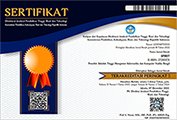PENERAPAN GAMIFICATION UNTUK ONLINE MARKETING HASIL PANEN KOMUNITAS PETANI SAYUR DAN BUAH ORGANIK DI DESA PENANGGUNGAN KABUPATEN MOJOKERTO
Abstract
Abstract : In Penanggungan Village, Mojokerto Regency, East Java, there are several organic vegetable and fruit farmer communities consisting of farmers and some middlemen / collectors of their crops. However, based on the observations of these farmers, it is difficult to market their crops. So far, the harvest products in the form of organic vegetables and fruit are generally sold to the surrounding community or sold to middlemen / collectors first. There are also those that are marketed directly to large stores / supermarkets in the city. The problem that occurs is that shop / supermarket staff do not always arrive on time at harvest time or arrive late, resulting in organic vegetables and fruit being sold in conditions that are not as fresh as at harvest time. The second problem is that middlemen / collectors also find it difficult to get a definite profit, if the farmers sell directly to shops / supermarkets. To overcome the above problems, this study aims to create an online marketing application that can unite and connect the community of farmers, middlemen, and supermarket staff to be able to communicate directly and make buying and selling transactions using the 6D Framework Gamification method. This method was chosen in order to maintain user engagement, improve user experience, and motivate users to make buying and selling transactions based on the number of points collected.
Â
Keywords: Application, Online Marketing, Organic Vegetable and Fruit, GamificationFull Text:
PDF (Bahasa Indonesia)References
R. Pembangunan and J. Menengah, “Rencana Pembangunan Jangka Menengah Daerah (RPJMD),†Kab.Mojokerto, 2016.
J. Steinke and J. van Etten, “Gamification of farmer-participatory priority setting in plant breeding: Design and validation of ‘AgroDuos,’†J. Crop Improv., vol. 31, no. 3, pp. 356–378, 2017, doi: 10.1080/15427528.2017.1303801.
S. K. Bista, S. Nepal, N. Colineau, and C. Paris, “Using gamification in an online community,†Collab. 2012 - Proc. 8th Int. Conf. Collab. Comput. Networking, Appl. Work., no. January 2015, pp. 611–618, 2012, doi: 10.4108/icst.collaboratecom.2012.250526.
T. P. Rinjeni, “Penerapan Marketplace Penjualan Olahan Biji Kopi Berbasis Website,†2020.
G. Lucassen and S. Jansen, “Gamiï¬cation in Consumer Marketing - Future or Fallacy?,†Procedia - Soc. Behav. Sci., vol. 148, no. March, pp. 194–202, 2014, doi: 10.1016/j.sbspro.2014.07.034.
H. P. Lu and H. C. Ho, “Exploring the impact of gamification on users’ engagement for sustainable development: A case study in brand applications,†Sustain., vol. 12, no. 10, 2020, doi: 10.3390/su12104169.
A. Kardianawati, H. Haryanto, and U. Rosyidah, “Penerapan Konsep Gamifikasi Appreciative pada E-Marketplace UMKM,†Techno. Com, vol. 15, no. 4, pp. 343–351, 2016, [Online]. Available: http://publikasi.dinus.ac.id/index.php/technoc/article/view/1274.
R. Conaway and M. C. Garay, “Gamification and service marketing,†Springerplus, vol. 3, no. 1, 2014, doi: 10.1186/2193-1801-3-653.
K. Werbach and D. Hunter, “For the win: How game thinking can revolutionizeyour business. .,†Whart. Digit. Press, 2012.
B. T. Corp., “The 6D Approach to Gamification,†2018. https://medium.com/@Borderless/the-6d-approach-to-gamification-281391f51968.
Supriyanto, “Perancangan Penerapan Gamifikasi pada Media Informasi Ekowisata. ISSN: 1907-5022,†Semin. Nas. Apl. Teknol. Inf., pp. 15–18, 2017, [Online]. Available: supriyanto@tif.uad.ac.id%0A.
DOI: http://dx.doi.org/10.53567/spirit.v12i2.179
Refbacks
- There are currently no refbacks.
Copyright (c) 2020 Jurnal SPIRIT
Diindeks Oleh:
SPIRIT : Sarana Penunjang Informasi Terkini
Diterbitkan oleh Teknologi Informasi Institut Teknologi dan Bisnis Yadika Pasuruan
Alamat Redaksi: Jl. Bader No.9, Kwangsan, Kalirejo, Kec. Bangil, Pasuruan, Jawa Timur 67153
Telp/Fax: (0343) 742070 , Email : lppm@stmik-yadika.ac.id
Google Maps : Klik Disini

Karya ini dilisensikan di bawah Lisensi Internasional Creative Commons Atribusi 4.0 .







1.png)







